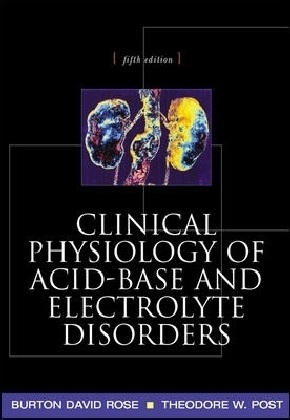Read more
Superbly written text gives students, residents, and practitioners a unique advantage in understanding the mechanisms and clinical management of acid-base disorders. Presents the core information to understand renal and electrolyte physiology and also reviews the etiology, diagnosis, pathohysiology and treatment rationale for all major acid-base and electrolyte disturbances. New questions and answers are added to each chapter with significant updating to the entire text
List of contents
Part One: Renal Physiology. Chapter 1: Introduction to Renal Function. Chapter 2: Renal Circulation and Glomerular Filtration Rate. Chapter 3: Proximal Tubule. Chapter 4: Loop of Henle and the Countercurrent Mechanism. Chapter 5: Functions of the Distal Nephron. Chapter 6: Effects of Hormones on Renal Function. Part Two: Regulation of Water and Electrolyte Balance. Chapter 7: The Total Body Water and the Plasma Sodium Concentration. Chapter 8: Regulation of the Effective Circulating Volume. Chapter 9: Regulation of Plasma Osmolality. Chapter 10: Acid-Base Physiology. Chapter 11: Regulation of Acid-Base Balance. Chapter 12: Potassium Homeostasis. Part Three: Physiologic Approach to Acid-Base and Electrolyte Disorders. Chapter 13: Meaning and Application of Urine Chemistries. Chapter 14: Hypovolemic States. Chapter 15: Clinical Use of Diuretics. Chapter 16: Edematous States. Chapter 17: Introduction to Simple and Mixed Acid-Base Disorders. Chapter 18: Metabolic Alkalosis. Chapter 19: Metabolic Acidosis. Chapter 20: Respiratory Acidosis. Chapter 21: Respiratory Alkalosis. Chapter 22: Introduction to Disorders of Osmolality. Chapter 23: Hypoosmolal States - Hyponatremia. Chapter 24: Hyperosmolal States - Hyponatremia. Chapter 25: Hyperosmolal States - Hyperglycemia Chapter 26: Introduction to Disorders of Potassium Balance. Chapter 27: Hypokalemia. Chapter 28: Hyperkalemia. Chapter 29: Answers to the Problems. Chapter 30: Summary of Equations and Formulas.
About the author
McGraw-Hill authors represent the leading experts in their fields and are dedicated to improving the lives, careers, and interests of readers worldwide
Summary
Gives students a unique advantage in understanding the mechanisms and clinical management of acid-base disorders. This book presents the information needed to understand renal and electrolyte physiology and also reviews the etiology, diagnosis, pathohysiology and treatment rationale for acid-base and electrolyte disturbances.

